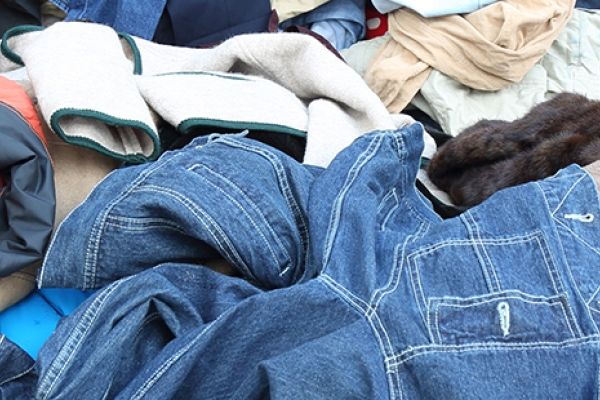SCIRT paves the way for a more sustainable fashion industry
The completion of the groundbreaking SCIRT project (System Circularity & Innovative Recycling of Textiles) represents a significant milestone in the shift towards a circular textile industry. After more than three years of intensive research, development, and collaboration among research organisations, fashion brands, textile manufacturers, and recycling companies, SCIRT has proven that a more sustainable fashion industry is within reach.

Textile consumption in Europe is the fifth-largest environmental and climate impact after food, housing, restaurants and hotels, and transport. In 2022, it was responsible for the fourth-highest pressure on water use, the fifth-highest demand on land and resources, and the fifth-highest contribution to greenhouse gas emissions. Furthermore, most of these clothing and textiles remain in circulation for a very short time, leading to a throwaway economy. On average, Europeans discard 16 kg of textiles per person each year.
The SCIRT innovation project brought together European research organisations, fashion brands, textile manufacturers, and recycling companies to address the technological, economic, socio-economic, and regulatory barriers to textile recycling, with the goal of creating a sustainable, circular fashion economy.
“SCIRT has been a challenging but highly rewarding project. Over the past few years, we’ve learned a great deal. In addition to the important technological and production advancements, the policy recommendations based on our research and stakeholder interactions are a major outcome. We hope to share these insights with Europe and the wider industry.”
– Evelien Dils, VITO
Turning waste textiles into new collections
SCIRT successfully demonstrated a fully integrated textile-to-textile recycling system. It showed that high-quality clothing can be produced from discarded textiles through advanced recycling processes.
Project partner Valvan refined its Fibersort technology, enabling the precise, automated sorting of large quantities of textile waste based on fibre composition and colour. Additionally, Valvan developed a machine that removes zips and buttons, improving the purity of the starting material and, consequently, the quality of the recycled fibres.
One of the main challenges in textile recycling is elastane, which is commonly used to improve stretch and comfort but is difficult to separate from other fibres, complicating the recycling process. At SCIRT, TU Wien developed a method to detect and remove elastane using non-toxic solvents, without damaging other fibres. However, until this technology is scaled up, the recommendation remains to limit elastane in textiles.
The most visible result of SCIRT is the creation of new yarns and garments. For example, Belgian brand Xandres developed a two-piece suit made from 17% recycled wool from collected clothing, 36% recycled polyester (from PET bottles), 25% polyester, and 22% wool. Circular denim brand HNST produced jeans made from 75% recycled cotton and a sweater containing 50% recycled cotton. Decathlon developed a swimsuit designed to last longer, be easier to recycle, and made from 93% recycled polyester. It also includes an RFID tag, making it easier to track and sort the swimsuit when it is discarded.
Evaluating the true cost of fashion
In addition to advancing recycling technologies and creating new sustainable fibres and garments, SCIRT focused on non-technological measures to support the transition to a circular system. VITO and Flanders DC developed the True Cost Calculator, a free self-assessment tool available at truecostcalculator.eu. This tool enables fashion professionals to map, compare, and reduce the ecological and social impact of clothing throughout its lifecycle, supporting more sustainable design decisions.
A key feature of the True Cost Calculator is its integration of financial, environmental, and social dimensions. It expresses the societal impacts of production, care, and disposal of clothing in intuitive monetary terms. As the SCIRT project concludes, VITO aims to expand the use of the True Cost model in a broader context.
Get started with the True Cost Calculator
How governments can support the transition
While SCIRT has advanced technological solutions, appropriate policy interventions are crucial for enabling the transition to a circular fashion system. These include:
- Clear definitions: Establishing precise definitions of what constitutes circular or sustainable fashion to prevent greenwashing.
- Mandatory recycled content: Setting targets for recycled material in specific products to drive improvements in collection systems, sorting, and recycling technologies.
- Product standards: Creating benchmarks for sustainable public procurement, and banning products that fail to meet these standards. Effective monitoring and enforcement are necessary to ensure a level playing field and prevent the market from being flooded with low-quality, unsustainable products.
- Harmonised producer responsibility: Implementing consistent Extended Producer Responsibility (EPR) systems for textiles across Europe, with clear goals, aligned innovation programmes, and eco-modulation criteria.
- Eco-design policies: Promoting the use of recycled content and introducing product passports at the EU level to align with EPR systems and foster synergies.
SCIRT partners
-
Fashion brands: Bel&Bo, HNST, Decathlon, Xandres, Petit Bateau
-
Research organisations: VITO, CETI, Prospex Institute
-
Universities: BOKU, TU Wien, ESTIA
-
Industry players: Altex, AVS Spinning – A European Spinning Group (ESG) Company, Valvan
-
SMEs: Circular.fashion, FFact
-
Non-profit organisations: Flanders DC, IID-SII







